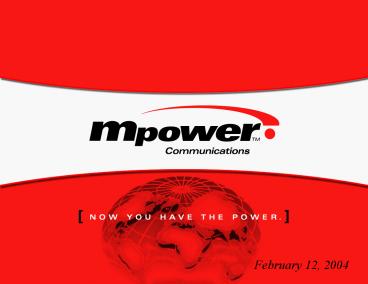February 12, 2004 - PowerPoint PPT Presentation
1 / 31
Title:
February 12, 2004
Description:
Operations in Los Angeles, San Diego, Las Vegas, Chicago and Northern California ' ... residential, mostly in Las Vegas. Largely acquired through direct sales ... – PowerPoint PPT presentation
Number of Views:43
Avg rating:3.0/5.0
Title: February 12, 2004
1
February 12, 2004
2
Statement of Operations
3
Balance Sheet
4
Business Overview
- Operations in Los Angeles, San Diego, Las Vegas,
Chicago and Northern California - Smart-build CLEC
- A facilities-based network integrating
state-of-the-art voice and high-speed data
applications - No resale or UNE-P
- Customer profile
- Retail only
- No wholesale customers
- Small-to-Medium Enterprise (SME)
- Some residential, mostly in Las Vegas
- Largely acquired through direct sales force
- Some agent relationships
- Some telemarketing
5
Market Overview
As of December 31, 2003
6
Service Overview
- Integrated Voice and High Speed Internet Access
- 4 to 24 voice lines with high speed Internet
access over a UNE T1 loop - Dedicated High Speed Internet Access
- 1.54 Mbps of synchronous speed Internet access
over a UNE T1 loop - Variable Synchronous speed Internet access over a
UNE DSL loop - Voice Transport
- Trunks PRI
- Inbound and Outbound
- 2-way
- DID
- Plain Old Telephone Service (POTS)
- Complementary Services
- Long Distance
- Centrex
- Calling card
- Toll-free
- Full voice features including voicemail, call
forwarding, caller ID, etc. - Full data features including web hosting,
dial-up, and remote access
7
Components of Revenue
- Recurring Customer
- Revenue received from customers every month for
services described on prior page - Recurring Switched Access
- Revenue received from inter-exchange carriers
(IXCs), or long distance companies - Arises from long distant usage by our customers
who pick a carrier other than Mpower for their
long distance service - Non-Recurring Customer
- Revenue received from customers for installation
of new service - Offsets our cost of acquiring the customer
8
Ending Access Lines in Service
9
Average Access Lines in Service
10
Gross Access Line Additions
11
Gross Access Line Disconnects
12
Access Line Churn
13
Access Line Churn
14
Revenue
NOTES 1. Non-Recurring Revenue is revenue billed
to customers for the initial installation of
service. 2. Residential Recurring Revenue is the
total amount of revenue billed to residential
customers plus a portion of switched access
revenue allocated between business and
residential lines on a pro-rata basis. 3.
Business Recurring Revenue is the total amount of
revenue billed to business customers plus a
portion of switched access revenue allocated
between business and residential lines on a
pro-rata basis.
15
Revenue Metrics
NOTES 1. Average Monthly Recurring Revenue per
Business Access Line is calculated by taking the
average number of Business lines in service for
the quarter divided by the Recurring Business
Revenue for the quarter divided by 3. 2. Average
Monthly Recurring Revenue per Residential Access
Line is calculated by taking the average number
of Residential lines in service for the quarter
divided by the Recurring Residential Revenue for
the quarter divided by 3.
16
Cost of Operating Revenue
NOTES 1. Non-Recurring Customer Costs are
one-time costs we are billed by the LEC for
initiating new service for our customers. 2. Real
Estate Costs are costs associated with our
collocations and our switch sites. 3. Network
Costs are costs associated with connecting our
collocations to our switch sites and our switch
sites to other carriers. 4. Recurring Customer
Costs are costs directly associated with customer
lines including monthly loop expenses, toll
charges, and other recurring customer
costs.
17
Operating Cost Metrics
NOTES 1. Monthly Recurring Customer Costs per
Average Access Line in Service is the quarterly
Recurring Customer Cost of Operating Revenue
divided by the average number of total access
lines in service for the quarter divided by 3. 2.
Monthly Network Costs per Average Access Line in
Service is the quarterly Network Cost of
Operating Revenue divided by the average number
of total access lines in service for the
quarter divided by 3. 3. Monthly Real Estate
Costs per Average Access Line in Service is the
quarterly Real Estate Cost of Operating Revenue
divided by the average number of total
access lines in service for the quarter divided
by 3.
18
Gross Margin
19
Selling, General Administrative
NOTES 1. Acquisition SGA is all of the SGA
incurred in connection with the sale and
installation of new lines during the quarter. 2.
Maintenance SGA is all other SGA not included
in Acquisition SGA.
20
SGA Metrics
NOTES 1. Acquisition Expense per Gross Business
Access Line Addition is equal to Acquisition SGA
(associated with Business Lines) plus Non-
Recurring Customer Cost of Operating Revenue
(associated with Business Lines) minus
Non-Recurring Customer Revenue (associated with
Business Lines) all divided by the Gross
Business Access Line Additions. 2. Acquisition
Expense per Gross Residential Access Line
Addition is equal to Acquisition SGA (associated
with Residential Lines) plus Non- Recurring
Customer Cost of Operating Revenue (associated
with Residential Lines) minus Non-Recurring
Customer Revenue (associated with
Residential Lines) all divided by the Gross
Residential Access Line Additions.
21
SGA Metrics
22
SGA Metrics
23
SGA Metrics
NOTES 1. Monthly Maintenance Expense per Average
Access Line in Service is equal to the
Maintenance SGA divided by the Average Access
Lines in Service divided by 3.
24
Adjusted EBITDA
25
GAAP Reconciliation
26
Net Income / (Loss)
27
Capital Expenditures
28
Independent Asset Appraisal
NOTE 1. As of July 31, 2002, prior to Fresh
Start Accounting implemented with our emergence
from bankruptcy. This is not intended to be a
comparison of our current gross or net PPE on
our balance sheet as of December 31, 2003, which
was 32,394,000.
29
Stock Options Outstanding
As of December 31, 2003
30
Current Adjusted Enterprise Valuation
As of February 11, 2004
31
(No Transcript)


















![Division of Revenue Bill 2004 [B4-2004] PowerPoint PPT Presentation](https://s3.amazonaws.com/images.powershow.com/A1262287349ZGYac.th0.jpg?_=20160529073)












